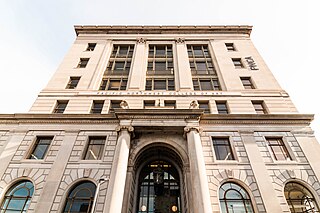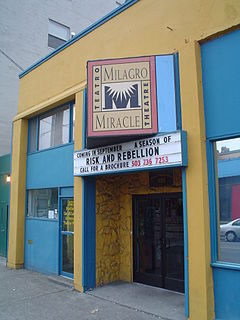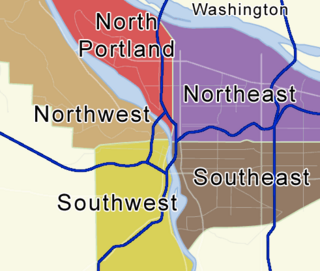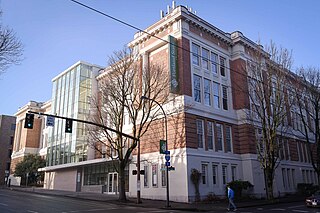
The Portland Institute for Contemporary Art (PICA) is a contemporary performance and visual arts organization in Portland in the U.S. state of Oregon. PICA was founded in 1995 by Kristy Edmunds. Since 2003, it has presented the annual Time-Based Art Festival (TBA) every September in Portland, featuring contemporary and experimental visual art, dance, theatre, film/video, music, and educational and public programs from local, national, and international artists. As of November 2017, it is led by Executive Director Victoria Frey and Artistic Directors Roya Amirsoleymani, Erin Boberg Doughton, and Kristan Kennedy.

The Oregon Shakespeare Festival (OSF) is a regional repertory theatre in Ashland, Oregon, United States, founded in 1935 by Angus L. Bowmer. From late February through October each year, the Festival now offers 800 to 850 matinee and evening performances of a wide range of classic and contemporary plays not limited to Shakespeare to a total annual audience of nearly 400,000. The Festival welcomed its millionth visitor in 1971, its 10-millionth in 2001, and its 20-millionth visitor in 2015. At any given time between five and eleven plays are offered in daily rotation six days a week in its three theatres.

Hopkins Center for the Arts at Dartmouth College is located at 2 East Wheelock Street in Hanover, New Hampshire. The center, which was designed by Wallace Harrison and foreshadows his later design of Manhattan's Lincoln Center, is the college's cultural hub. It is home to the drama and music departments. In addition to these fields, the Hopkins Center, or the "Hop" as it is called by students, has a woodshop and jewelry studio which are open for use by students and the public.

Marylhurst University was a private applied liberal arts and business university in Marylhurst, Oregon. It was among the oldest collegiate degree-granting institutions in Oregon, having awarded its first degree in 1897. Marylhurst was founded as St. Mary's College and run for many years by the Sisters of the Holy Names of Jesus and Mary. The former campus is located about nine miles south of Portland, Oregon on the Willamette River. Although Marylhurst University was a Roman Catholic school, it served students of all faiths and backgrounds.

The Pacific Northwest College of Art (PNCA) is a private fine arts and design college in Portland, Oregon. Established in 1909, the art school grants bachelor of fine arts degrees and graduate degrees including the master of fine arts (MFA) and master of arts (MA) degrees. It has an enrollment of about 500 students. PNCA actively participates in Portland's cultural life through a public program of exhibitions, lectures, and internationally recognized visual artists, designers, and creative thinkers.

Tourism in Portland, Oregon is a profitable industry that serves many. In 2018, Portland area tourism generated $5.3 billion in direct spending by 8.6 million overnight person-trips and employs 36,360 people who were paid $1.5 billion.

Miracle Theatre, sometimes known by the Spanish translation of its name Teatro Milagro, is the only Hispanic theater production company in the Pacific Northwest. Its home is in Portland, Oregon, United States, though it often tours regionally and nationally. It was founded in 1985.

There are five addressing sections of Portland, Oregon, with a sixth to be implemented on May 1, 2020. There are 95 officially recognized neighborhoods, each of which is represented by a volunteer-based neighborhood association. No neighborhood associations overlap the Willamette River, but a few overlap the addressing sextants. For example, most addresses in the South Portland Neighborhood Association are South, but a portion of the neighborhood is west of SW View Point Terrace where addresses have a SW prefix. Similarly the Buckman Neighborhood Association spans both NE and SE Portland. Neighborhood associations serve as the liaison between residents and the city government, as coordinated by the city's Office of Community & Civic Life, which was created in 1974 and known as the Office of Neighborhood Involvement until July 2018. The city subsequently provides funding to this "network of neighborhoods" through district coalitions, which are groupings of neighborhood associations. A few areas of Portland are "unclaimed" by any of the 95 neighborhood associations in Portland.
Juniper Shuey is a Seattle-based visual artist, known for his video installations and sculptural performance. He is the Co-Artistic Director of zoe|juniper and is the Head Carpenter at the University of Washington Meany Hall. Since establishing himself in the late 1990s he has continued to gain a professional reputation for his works.
Zoe Scofield is a choreographer and dancer best known for her work with Juniper Shuey as co-directors of zoe|juniper, a Seattle-based dance and visual art company. Her work is characterized by multi-media, cross-genre works utilizing stage performance, video installation, photography and complex technical elements.

The culture of San Antonio reflects the history and culture of one of the state's oldest and largest cities straddling the regional and cultural divide between South and Central Texas. Historically, San Antonio culture comes from a blend of Southern (Dixie), Western (frontier), and Southwestern. Founded as a Spanish outpost and the first civil settlement in Texas, San Antonio is heavily influenced by Mexican American culture due to Texas formerly being part of Mexico and, previously, the Spanish Empire. The city also has significant German, Anglo, and African American cultural influences. San Antonio offers a host of cultural institutions, events, restaurants and nightlife in South Texas for both residents and visitors alike.

Washington High School was a high school in Portland, Oregon, United States, from 1906 to 1981. After fire destroyed the original building, a new building was completed in 1924. The school merged with Monroe High School in 1978 to become Washington-Monroe High School. The school closed shortly after in 1981, and the building was vacant for many years. In October 2013, plans to renovate the building for commercial use were advancing, with a mix of retail and office use planned. New Seasons Market relocated its offices to the building in 2015 and is the largest tenant. The former auditorium was repurposed as a music venue called Revolution Hall, which opened in February 2015. The building was listed on the National Register of Historic Places in November 2015.
The Under the Radar Festival is a theater festival in New York City, founded in 2005 by Mark Russell, former Artistic Director of P.S. 122 for over twenty years and also Guest Artistic Director for the Portland Institute for Contemporary Art's Time-Based Art Festival from 2006-2008. Under the Radar has its headquarters at the Public Theater.
Hand2Mouth Theatre is theatre ensemble based in Portland, Oregon. The group collaboratively create their performances, and evolve all language, movement, and design elements themselves—instead of working from a pre-written script.

Lincoln Hall is an historic building located in Portland, Oregon, built in 1912. It is the home of the theatre, film, and performing arts departments at Portland State University. It was originally home to Lincoln High School before becoming a part of the Portland State College in 1955.
The culture of Oregon has had a diverse and distinct character from before European settlement until the modern day. Approximately 80 Native American tribes were living in Oregon before the establishment of European pioneer settlements. Trappers and traders were the harbingers of the coming migration of Europeans. Many of these settlers traveled along the nationally renowned Oregon Trail, with estimates of around 53,000 using the trail between 1840 and 1850.
Kristan Kennedy is an artist, curator, and educator in Portland, Oregon who has exhibited internationally. She works with various media including sculpture and painting.
Mack McFarland is a curator and artist living in Portland, Oregon. He is the Director of Center for Contemporary Art & Culture at Pacific Northwest College of Art.
Matilda "Red" Bickers is an American artist, writer, and sex worker rights activist. She has written for the now-defunct $pread, Tits and Sass, and the Red Umbrella Project.